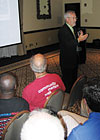
George Tuhowski of the Chicago Chapter of the USGBC describes LEED certification to an audience at the first ever Northern Illinois Branch meeting of the chapter.
Motivating all those involved in the construction process, including contractors, to consider plugging into LEED recognition is an ongoing process, just as it is an ongoing process to keep up with the changes.
For those reasons, members of the Chicago Chapter of the U.S. Green Building Council (USGBC) recently headed some 80 miles west to the Rockford, Ill., area for a Going Green to LEED event. And while providing information on LEED was priority one, the westward journey was yet another reflection of the growth and changes going on within USGBC.
The meeting at a local hotel was the first for the newly formed Rockford/Northern Illinois Branch of the Chicago Chapter, the latter of which was also planning to change its name to the Illinois Chapter to better reflect its expanding territory.
At that meeting, George Tuhowski III, vice chair of Chicago USGBC and general superintendent for Leopardo Construction of Hoffman Estates, Ill., told about 100 persons that going after LEED certification is as much about “care for the environment as it is a way to make a living.”
He noted the focus on energy conservation means those involved in a LEED-registered project “can make a difference and can still make money.”
In a separate interview conducted byThe NEWSa few days after that event, Phil Mutz of Moncrief Heating & Air Conditioning of Atlanta focused specifically on the role of HVAC contractors. “HVAC plays a very big role in projects seeking LEED certification. It is one of the larger sections with a lot of available points. (Accumulation of points leads to the various levels of certification). That makes sense because HVAC accounts for nearly half of a home or building’s energy usage.”
He noted that while HVAC contractors are typically hired after the design work has been done and a level of certification targeted, “being a contractor that is LEED-accredited should help win business. LEED buildings typically use high-efficiency, cutting-edge systems and some outside-of-the-box application of products. Proper installation and setup are critical to ensure design performance.”
LEED V3
At the Chicago Chapter meeting, Tuhowski said LEED v3 was created to make sure the rating system uses new technologies and better addresses energy use and CO2 emissions.“This system addresses credit harmonization, credit weighting, and regionalization as well as updating standards,” he said.
USGBC said harmonization involves “LEED credits and prerequisites that have been consolidated, aligned, and updated to reflect their most effective common denominator providing a consistent pool of prerequisites and credits across the commercial and institutional LEED rating systems.” The revised credit weighings “now awards more points for strategies that will have greater positive impact on what matters most: energy efficiency and CO2 reductions.”
Regionalization means that “depending on a project’s specific location, six existing LEED credits from LEED’s various credit categories that address regional environmental issues have been assigned ‘bonus points.’”
As noted by Mutz, “Each new version does improve the overall process and refine the goal of the entire LEED program, which is a good thing.”

Prairie Hill School Supt. Ted Rehl describes how planners for his new school sought LEED certification.
LEED AP
Yet another aspect of LEED that can affect contractors is the Accredited Professional (AP) program designed, according to the USGBC, to demonstrate “a professional’s knowledge of the most current version of LEED.”Mutz, who is a LEED AP, said contractors should consider doing the study and testing to gain the recognition. He said, “We (at Moncrief) are taking LEED pretty seriously and are, I hope, on the forefront of HVAC contractors to actually have APs on staff.”
The LEED Professional Accreditation program is managed by the Green Building Certification Institute (GBCI). According to the USGBC the program “recognizes professionals who have demonstrated a thorough understanding of green building techniques, the LEED green building rating systems, and the certification process. It was established with the support of USGBC to allow for objective, balanced management of the credentialing program.”
PROJECTS
The Chicago Chapter’s push into northcentral Illinos, as reflected in the mid-September meeting, was designed to make more people aware of LEED and motivate building owners and engineers to factor in some level of LEED certification as part of the planning process.In that regard, presenters outlined two recent projects in the area involved in LEED certification.
The new Prairie Hill School in South Beloit, Ill., earned LEED Silver. Part of that involved innovations on the HVAC side as with 50 closed-loop water-source heat pumps, 17 energy recovery ventilators, as well as variable pumping. The idea was that even though front-end costs were higher than a conventional system, there ended up being lower operating and maintenance costs.
The superintendent of the Prairie Hill School District, Ted Rehl, told the audience, “LEED Silver had everything to do with our children, our most precious resource.” Thanks to the IAQ, he said, “Our kids are happier, brighter, and wider awake.”
Another project cited at the meeting was the renovation to the physical education center at Rock Valley College in Rockford that encompassed “a complete overhaul of the mechanical systems, which included heating, ventilation, air conditioning, electrical wiring, and plumbing,” the college said in a statement. It added, “This building will be the first of its kind in Rockford. The architect team has incorporated a green build philosophy in the building’s design. It is the college’s goal to achieve a Gold-level LEED status.”
The achievement came not without challenge, said presenters during the branch meeting. As one presenter noted, “Some contractors are just learning the word LEED, so there is some training involved.”
For more information, visit www.usgbc-chicago.org and/or gbci.org.
Publication date:11/09/2009




